Has your Windows system slowed down due to excessive hard drive activity?
Do you see a constant flickering of hard drive activity light when working on Windows system?
If yes, this post is exactly for you. In this post, we will look at some solutions to fix this issue.
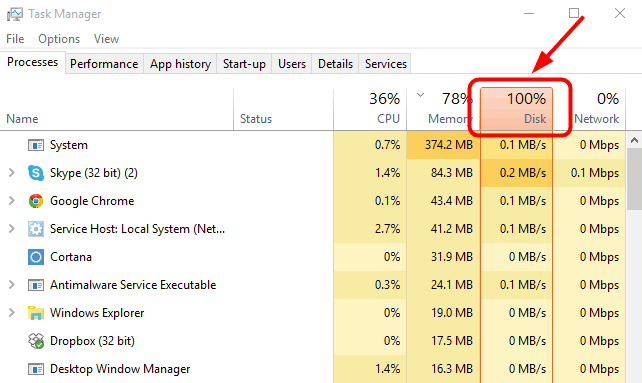
With that said, you don’t need to try all solutions. Start with Solution One and just work your way down until the issue is fixed.
After trying every solution, open the Task Manager -> Processes tab -> Disk column to see if the hard drive usage has reduced or looks normal. If the issue is not resolved, try next solution.
Solution One – Disable Windows Search
The Windows search service indexes files on your hard drive. It is listed as searchinsexer.exe under Processes tab in Task Manager. The indexing runs in the background for which the hard drive is accessed.
The activity of Windows search service could be one of the reasons behind 100% disk utilization and disabling the Windows search service could resolve the issue. Before disabling Windows search service, you need to first ascertain whether the search service is behind the 100% disk utilization by disabling it temporarily.
If the Windows search service is causing 100% disk usage, you can disable it permanently to fix the issue. Below you will find steps to disable Windows search services temporarily and permanently.
Steps to temporarily disable Windows Search Service
- Go to Desktop
- Type cmd in the search bar
- In the list of results, right-click Command Prompt and select Run as administrator
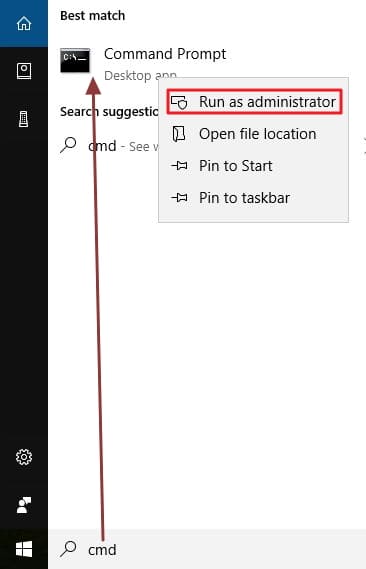
- Click Yes when prompted by User Account Control
- In command prompt window, type net.exe stop “Windows search”
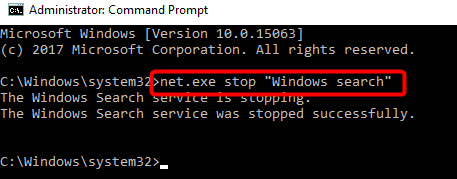
- Hit enter on your keyboard
- Open the Task Manager and click Processes If you see hard drive usage has reduced significantly in the Disk column, you can draw a conclusion the Windows search services is the reason for 100% high disk usage

Now you can go ahead and disable the Windows Search Services permanently by following steps given below.
Steps to permanently disable Windows Search Service
- On your keyboard, press Windows key and R simultaneously to invoke Run command
- In Run command box, type services.msc
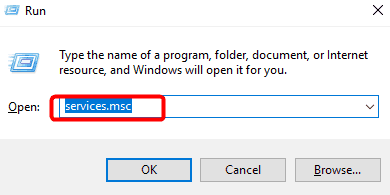
- In the Services window, look for Windows Search option and double-click on it
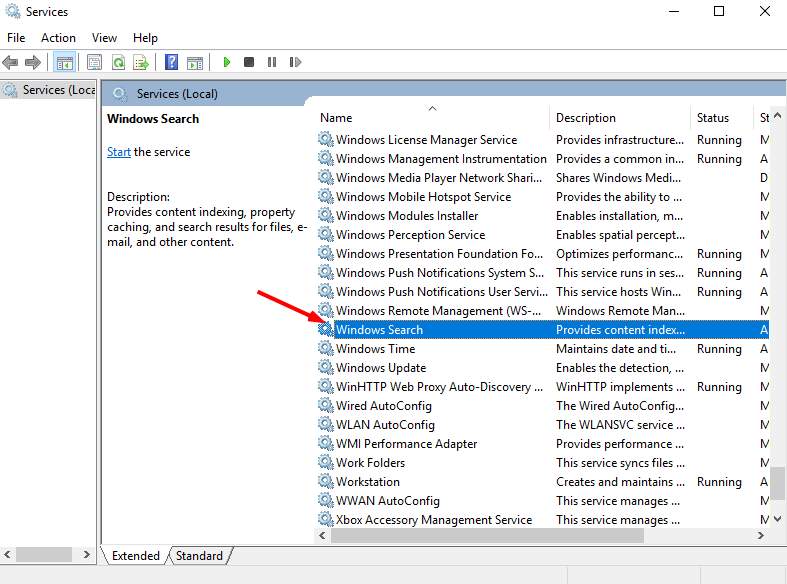
- Click Properties
- Under Startup type– select Disabled from the drop-down list
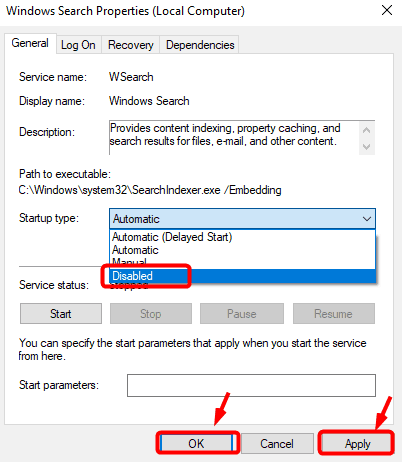
- Click Apply and then click OK
- Close the Service window
Solution Two- Disable SuperFetch
Superfetch is part of Windows memory manager which caches data to enhance the performance of the application. The Superfetch service caches the often-accessed data after it makes sure the data can be read fast from RAM than hard disks.
However, Superfetch is known to cause some disk performance issues in Windows 8 and later Windows OS versions including Windows 10. You need to stop the Superfetch service and see if it lowers disk usage. Here are the steps to follow.
- Go to Desktop
- Type cmd in the search bar
- In the list of results, right-click Command Prompt and select Run as administrator
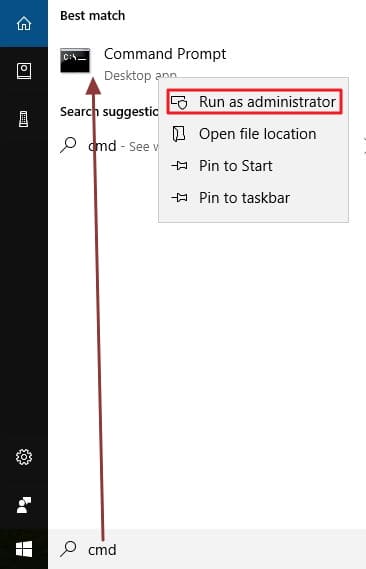
- Click Yes when prompted by User Account Control
- In command prompt window, type net.exe stop superfetch

- Press Enter on the keyboard
- In Windows search bar, type Task manager
- Select Task manager from a list of results
- Go to the Processes If you see hard drive usage has reduced significantly in the disk column, you can draw a conclusion the Superfetch service is the reason for 100% high disk usage. Let it remain disabled as you have solved the problem.
Solution Three – Do a Disk check
- Go to Desktop
- Type cmd in the search bar
- In the list of results, right-click Command Prompt and select Run as administrator

- Click Yes when prompted by User Account Control
- In the command prompt window, type exe /f /r
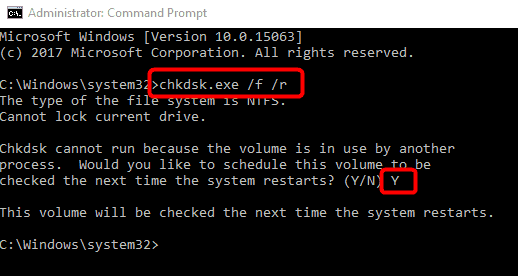
- Press Enter on your keyboard
- You will see a message in command prompt window that asks for confirmation to run check disk when the Windows boots next time. Type Y as an answer and hit enter on the keyboard.
- Close the command prompt Windows
Note- Windows will start the disk check when it boots next time. Check disk process can run for a long time depending on the size and state of the disk. Windows will present you with an option to skip the check disk process at the beginning. If you decide to skip check disk and let Windows boot normally, you need to repeat the steps above to schedule check disk during boot.
- Once Windows has completed check disk process, open Task Manager
- Check the Processes Look at Disk column and see if the hard disk usage has returned to normal. If yes, the problem is resolved
Solution Four – Reset Virtual Memory
Also known a page file, virtual memory is considered to be an extension of physical memory. It is a combination of your physical memory and a portion of a hard drive which Windows reserves as virtual memory. Whenever, there is 100% utilization of RAM, Windows stores some files in virtual memory and moves them back to RAM when needed.
Steps to reset Virtual Memory
- Press Windows key and Pause Break on your keyboard simultaneously
- In the next screen, select Advanced settings that appear on left side of the screen
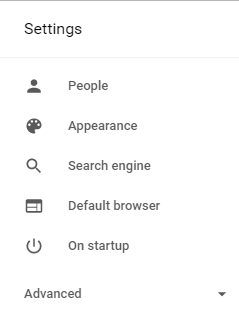
- Click the Advanced tab and then click Settings
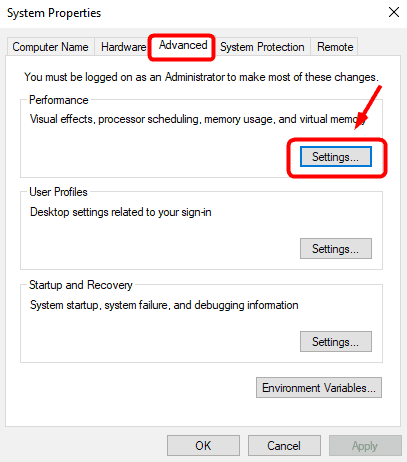
- In the next screen, click Advanced tab again and click Change under Virtual Memory section
- Look for the Automatically manage paging file size for all drives option and uncheck it
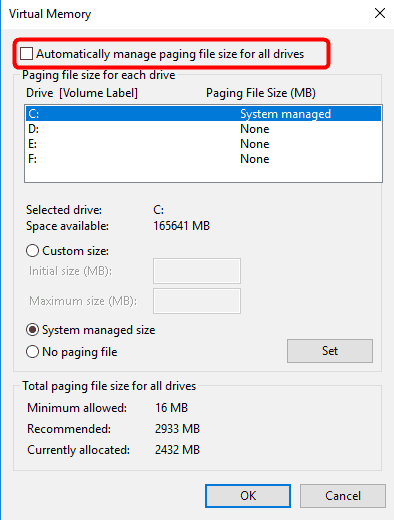
- Select C: drive in the list ( here you need to select driver where Windows OS is installed)
- Enter an Initial size and Maximum size for your virtual memory
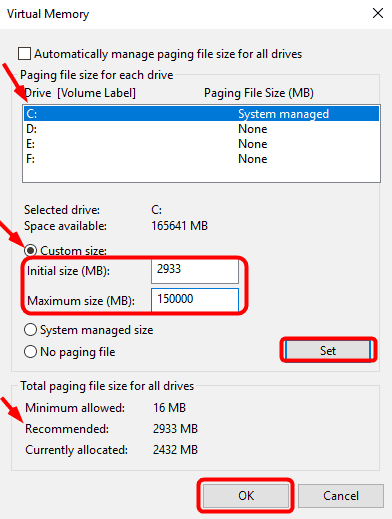
Note- The values that you need to enter in Initial size and Maximum size depends on your computer. If you are not sure about what to enter, you can enter the recommended value for the Initial size. The value for Maximum size can be 1.5 times of the total RAM size. For example, if you have 4GB RAM, you can enter 6,144 MB that is the output of 4096 MB x 1.5
- After you have entered both values for Virtual Memory, click Set
- Click OK
- Now you have to clear all temp files by following steps given below
- Press Windows key and R on the keyboard at the same time to invoke Run command
- Type temp in Run box and press Enter on the keyboard
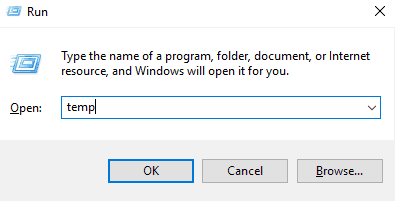
- This will open the temp folder and you will see all temp files
- Press Ctrl+A on your keyboard to select all files in the temp folder
- Press Delete on the keyboard to clear all temp files.
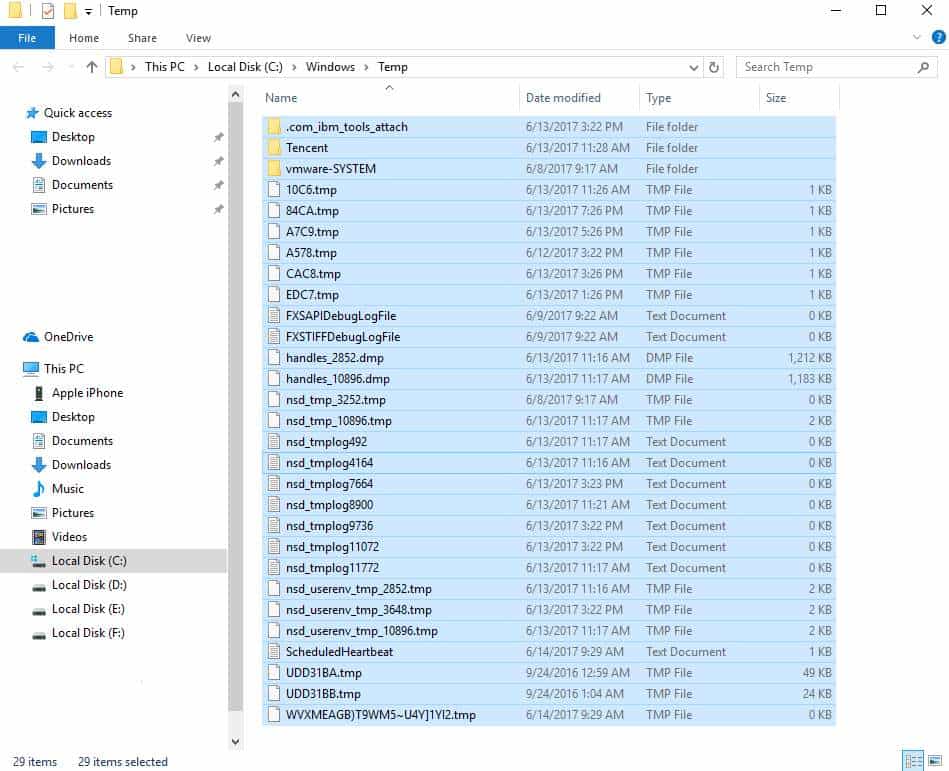
- Now open Task Manager and see if the disk usage has returned to normal.
Solution Five- Disable Antivirus temporarily
If you have installed a third-party antivirus like Kaspersky, Avast, Norton, AVG or any another antivirus, you need to disable it temporarily and see if it reduces hard disk usage.
Different antivirus programs might use different steps for disabling them. Therefore, it would be best if you go through the anti-virus documentation to know the exact steps. With that said, for most antivirus programs, the option to disable virus can be found by clicking the anti-virus icon in the system tray.
By default, Windows Defender, Microsoft’s own antivirus program, is turned on in Windows 10. Therefore, temporarily disabling a third-party antivirus software tool is not going to put your computer at risk.
Once you have disabled the anti-virus program, open the Task Manager and see if the disk usage has reduced.
If yes, that means the problem has been resolved. In that case, you need to contact the anti-virus manufacturer and explain the problem and ask for a solution.
Another option is to use other 3rd party anti-virus or use the inbuilt Windows Defender.
Solution Six- Change few Skype and Google Chrome settings
The combination of Skype and Google Chrome is known to be one of the causes of 100% disk usage. Making some changes in Settings can help resolve the issue. Here are the steps to follow.
Steps to change Google Chrome Settings
- Click the three vertical dots that appear in the top right corner of Google Chrome
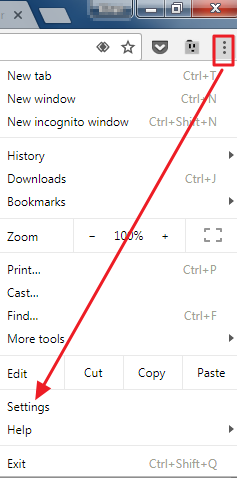
- Select Settings
- In the Settings window, look for the hamburger menu icon (three horizontal lines) at the top left corner of the Google Chrome window
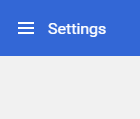
- Click Advanced and then click Privacy and Security
- Ensure the “Use a prediction service to load pages more quickly” is turned off
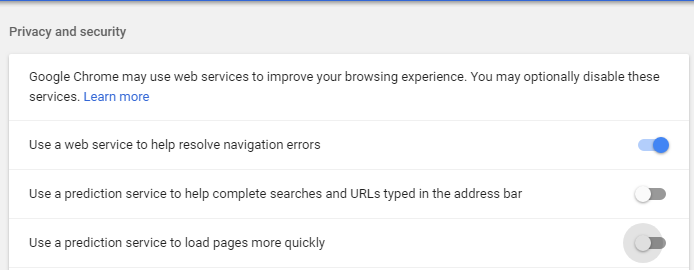
Steps to change Skype Settings
Before you perform any steps below, make sure Skype is not running.
- Go to Desktop and click This PC icon
- In Windows Explorer, select C: Drive
- Navigate to C:\Program Files (x86)\Skype\Phone\

- Locate exe file and right-click on it and select Properties
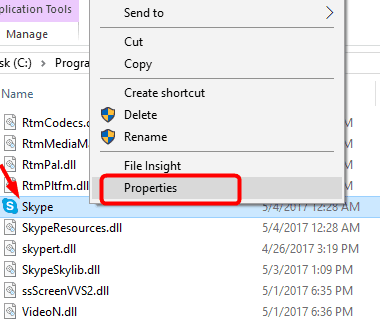
- Click Security tab and click Edit
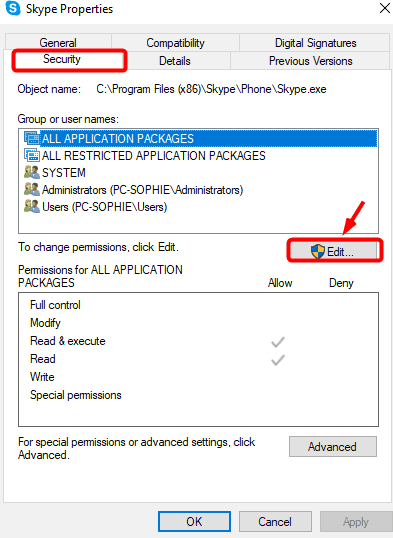
- Select ALL APPLICATION PACKAGES
- Under Permission for All Application packages, tick the Allow check box for Write.
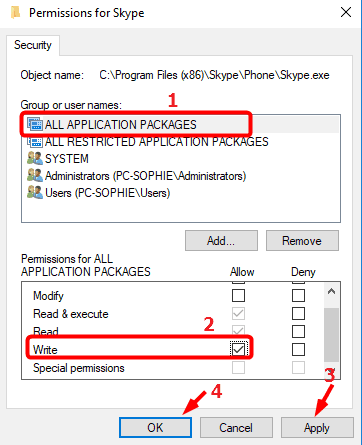
- Click Apply and then click OK
- Close all Windows
- Open Task Manager and click Processes Look at Disk column and see if the hard disk usage has returned to normal.
Solution Seven- Fix StorAHCI.sys driver
The 100% disk usage could be due to the problem with some drivers related to storage drives. As you know hard drives run in different modes such as AHCI, IDE, or RAID.
According to some reports, due to a firmware bug, Advanced Host Controller Interface PCI-Express (AHCI PCIe) runs with the inbox StorAHCI.sys driver that leads to a problem. Here are the steps to determine if that is the case with your computer and fix StorAHCI.sys driver.
- Press Windows logo key and X simultaneously on your keyboard
- Select Device Manager
- Click the IDE ATA/ATAPI Controllers category to expand it
- Double-click AHCI controller.
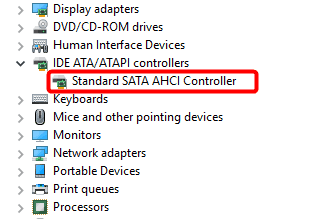
- Go to Driver tab and click Driver Details
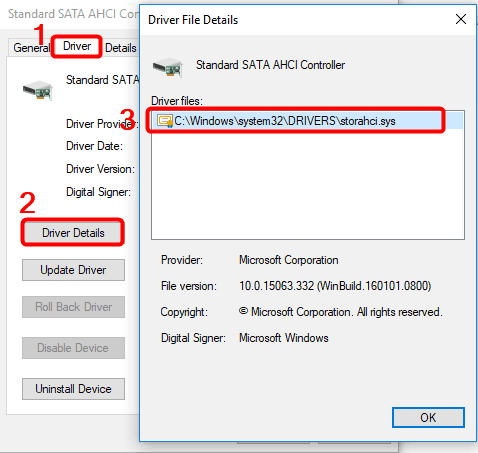
- See if the Driver File details window shows storahci.sys stored in the path of the system32 If yes, the system is running the inbox AHCI driver
- Close the Driver Details window and click Detail tab
- Under Property, select Device Instance Path from the drop-down menu
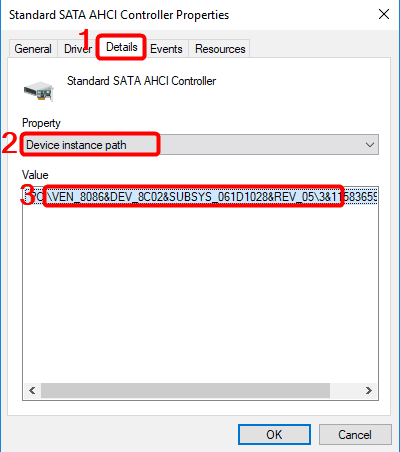
- Copy the path starting from Ven_
- Go to Start search box and type Regedit in the box
- Hit enter on the keyboard to run Registry Editor
- In Registry Editor window, go to
HKEY_LOCAL_MACHINE\System\CurrentControlSet\Enum\PCI\ <AHCI Controller>\<Random Number>\Device Parameters\Interrupt Management\MessageSignaledInterruptProperties
- The AHCI Controller value (starting from Ven-) that you copied can be seen here
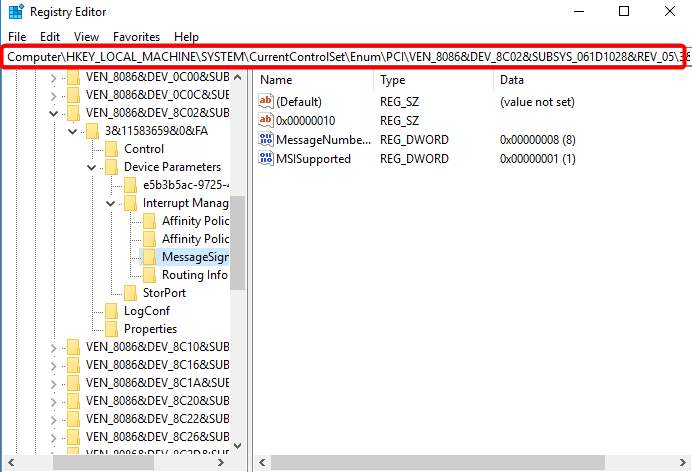
- Double-click the MSI Supported key and change its value to 0 (zero)
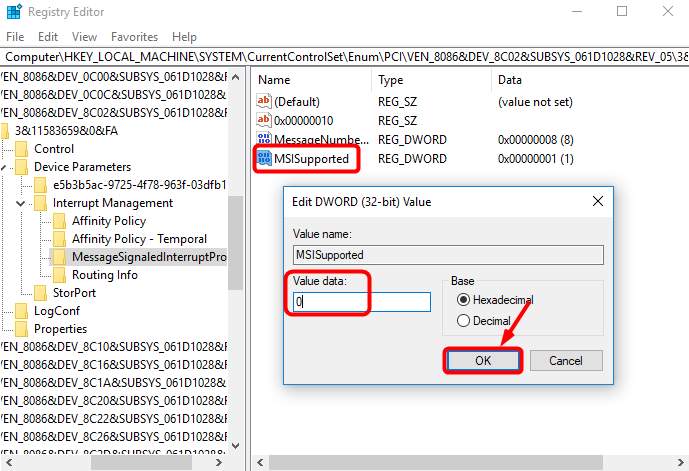
- Click OK
- Close Registry Editor
- Close all application Windows and open Task Manager
- Go to Processes tab and look at the Disk column and see if the Disk Activity has returned to 0 or normal
Solution Eight – Update Device Drivers
If none of the solutions have helped you resolve the 100% high disk usage problem, you need to update all device drivers and see if it fixes the issue. You have two options for updating drivers- Manually and Automatically.
Manual driver update– You need to go to device manufacturer website (for laptops) and manufacturer website (assembled desktops) to download latest drivers. You need to know the Windows version and architecture (32-bit and 64-bit) to download right drivers. Downloading driver manually needs some expertise. It is also a time-consuming task and you need to have lots of patience when updating drivers manually. If you are looking for simple way to update drivers, try Driver Update software.
Updating Drivers Automatically
Automatic driver update tools offer many benefits, the most important ones being:
- You can update device drivers automatically
- The software scans and updates all outdated or missing drivers at one go
- The tool picks the right drivers for your device and operating system, so you won’t have to worry about installing an incorrect driver by mistake
- Automatic driver updates are 100% safe
Driver Updater is one of the best driver update tools out there. Outbyte Driver Updater will give you access to a database of over 1 million drivers. It will regularly scan your PC, suggesting new driver versions to install. Driver Updater contains drivers for a variety of Windows devices. With just one click, you can update drivers in your system.
Step 1
Click here to Install and launch the app
Step 2
Scan all devices
Step 3
Install or update drivers automatically
Updating Drivers Automatically
Automatic driver update tools offer many benefits, the most important ones being:
- You can update device drivers automatically
- The software scans and updates all outdated or missing drivers at one go
- The tool picks the right drivers for your device and operating system, so you won’t have to worry about installing an incorrect driver by mistake
- Automatic driver updates are 100% safe
Driver Updater is one of the best driver update tools out there. Outbyte Driver Updater will give you access to a database of over 1 million drivers. It will regularly scan your PC, suggesting new driver versions to install. Driver Updater contains drivers for a variety of Windows devices. With just one click, you can update drivers in your system.
Step 1
Click here to Install and launch the app
Step 2
Scan all devices
Step 3
Install or update drivers automatically

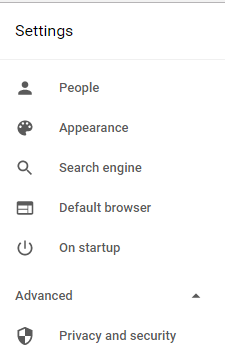
Leave a Reply